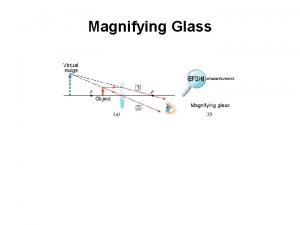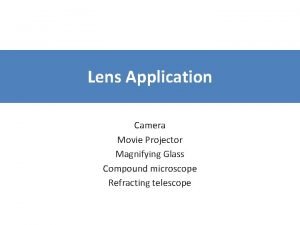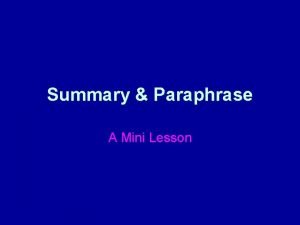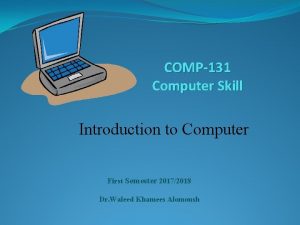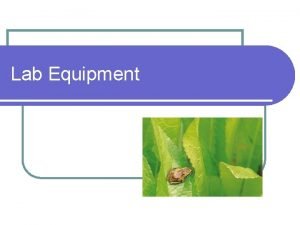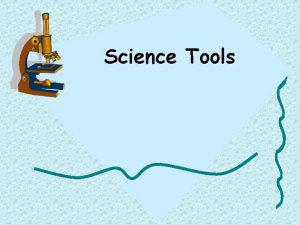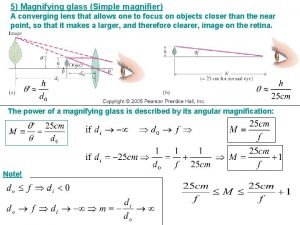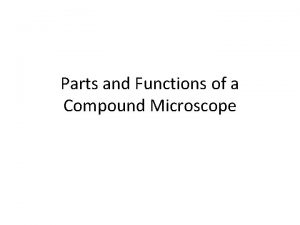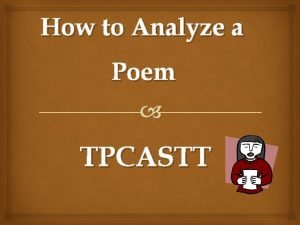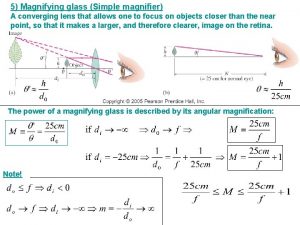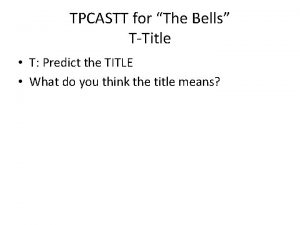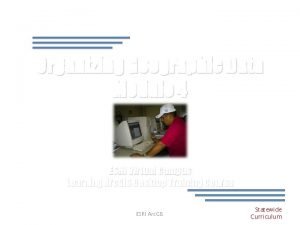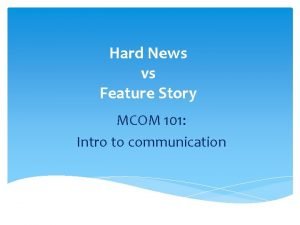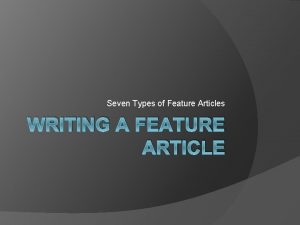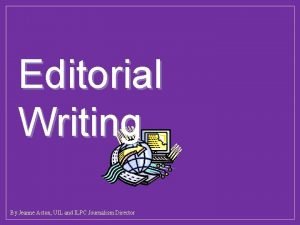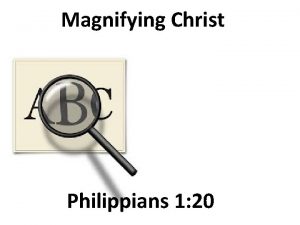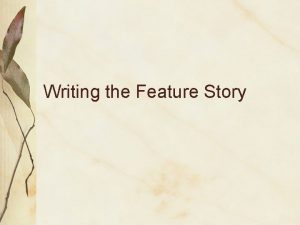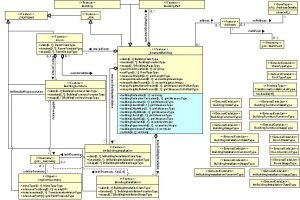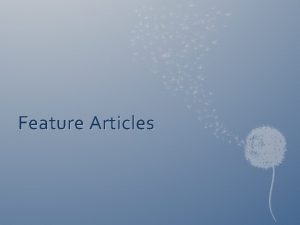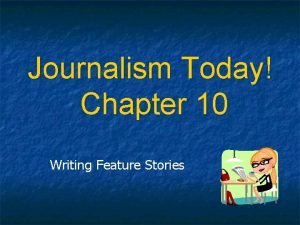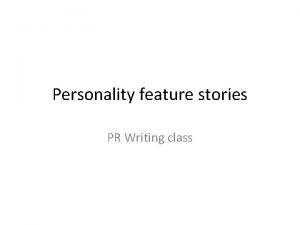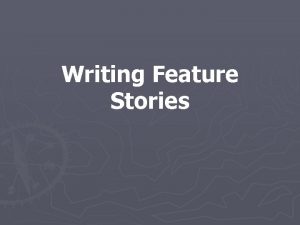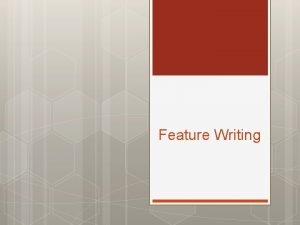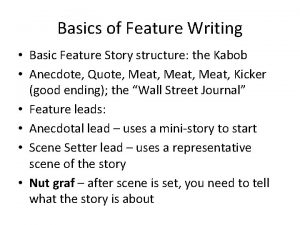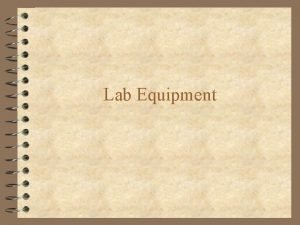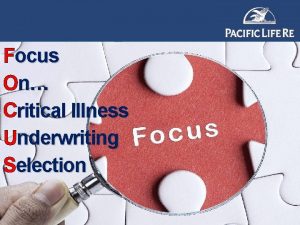Magnifying what is FEATURE WRITING What is feature



















- Slides: 19

Magnifying what is FEATURE WRITING

What is feature writing? Features are not meant to deliver the news firsthand. They do contain elements of news, but their main function is to humanize, to add color, to educate, to entertain, to illuminate. They often recap major news that was reported in a previous news cycle

Feature VS News Topics/Contents Hard News - Currents timely - New information - Facts, Figures statement by powerful people, etc Feature - Timely or timesless - New/Original/personal perspectives/angles - Personal observation and experiences, stories anecdotes

Functions of a Feature Article

Types of Features 1. Personality profiles Also called CHARACTER SKETCH. Interviews and observations, as well as creative writing, are used to paint a vivid picture of the person. A good profile includes impressions, explanations and points of view. It should emphasize what is unique about the person. You can use a flashback technique or highlight the individual’s many roles.

2. Human Interest Stories A human interest story is written to show a subject’s oddity or its practical, emotional, or entertainment value.

3. Trend stories A trend story examines people, things or organizations that are having an impact on society. Trend stories are popular because people are excited to read or hear about the latest fads.

4. In-depth stories Through extensive research and interviews, in depth stories provide a detailed account well beyond a basic news story or feature.

5. Backgrounders also called an analysis piece--adds meaning to current issues in the news by explaining them further. These articles bring an audience upto-date, explaining how this country, this organization, this person happens to be where it is now.

Writing & Organizing Feature Stories Feature writers seldom use the inverted pyramid form. The Commonly used styles are: • chronology that builds to a climax at the end, • a narrative, or • a first-person article about one of their own experiences or a combination of these. - stories are held together by a thread, and they often end where the lead started, with a single person or event.

HOW TO WRITE A GOOD FEATURE 1. • Choose theme. • Does the story have holding power (emotional appeal)? What makes the story worthy of being reported? The theme answers the question, "So what? " 2. • Write a lead that invites an audience into the story. • A summary may not be the best lead for a feature. The first two or three paragraphs set a mood, arouse readers, or invite them inside. 3. • Write the body • Then the news peg or the significance of the story is provided in the third or fourth paragraph, the nut graph. Because it explains the reason the story is being written, the nut graph--also called the "so what" graph--is a vital paragraph in every feature.

Useful tips * Some good feature leads include: Narrative, Descriptive, Striking statement and Punch or astonisher * Be clear about why you are writing the article. Is it to inform, persuade, observe, evaluate, or evoke emotion? * FOCUS! When you prepare for your feature story, you will gather a large amount of information through interviews and background research. Before you begin writing, focus on the main idea. WHY? ? ? Because focusing will narrow your topic

* After writing the lead, you need a structure in which to place the information. A structure is an organizational pattern used to synthesize, that is to establish relationships between relevant pieces of information. * Provide vital background information. If appropriate, a paragraph or two of background should be placed high in the story to bring the audience up to date.

Write in ACTIVE VOICE & if possible, present tense ACCURACY IS IMPORTANT. You can interpret and embroider but do not fudge. Keep your AUDIENCE clearly in mind. Avoid CLICHES… AVOID LENGTHY and COMPLICATED paragraphs.

• Write clear, concise sentences. Sprinkle direct quotations, observations and additional background throughout the story. Paragraphs can be written chronologically or in order of importance. Be creative, watch, & listen. . . • Read & Research • Keep up to date, take notes and play with words!

• Use transition. Connect paragraphs with transitional words, paraphrases, and direct quotations. • Transition is the tool writers use to move subtly from one person or topic to the next. IT keeps readers from being jarred by the writing.

Find the right VOICE When you write a story, you take on a persona, or character. You must choose a voice that best imparts the information in that story. The choice you make becomes the tone, or mood of the story, and it should always match the content. For instance, you would not use humor to write about a tragic auto accident.

body REMEMBER… The provides vital information while it educates, entertains, and emotionally ties an audience to the subject. The ending will wrap up the story & come back to the lead, often with a quotation or a surprising climax. Conclude with a quotation or another part of the thread. A feature can trail off like a news story or it can be concluded with a climax.

~~~ END ~~~ A presentation by Muhammad Taufik, SS, M Hum
 Lens used in magnifying glass
Lens used in magnifying glass Magnifying glass
Magnifying glass Angular magnification
Angular magnification Magnifying glass illustration
Magnifying glass illustration Google magnifying glass
Google magnifying glass Magnifying glass uses in laboratory
Magnifying glass uses in laboratory Science magnifying tool
Science magnifying tool Owl hierarchy
Owl hierarchy Magnification formula for lens
Magnification formula for lens Rotating disc where the objectives are attached
Rotating disc where the objectives are attached Function of compound microscope
Function of compound microscope The chucky poem summary
The chucky poem summary Simple magnifying glass
Simple magnifying glass Illustration
Illustration Isolated feature combined feature effects
Isolated feature combined feature effects Feature dataset vs feature class
Feature dataset vs feature class Feature story writing
Feature story writing Characteristics of narrative writing
Characteristics of narrative writing Feature article types
Feature article types Uil feature writing
Uil feature writing
